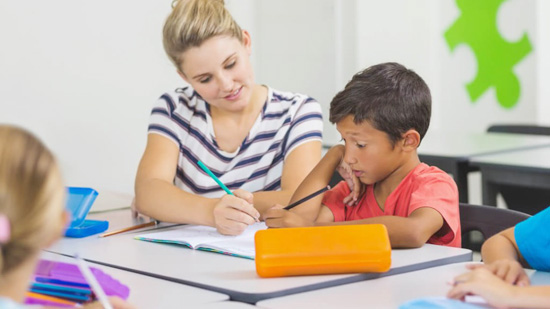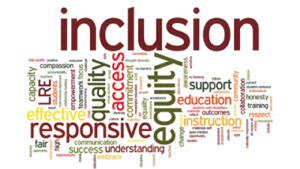In today’s inclusive society, the conversation surrounding education is shifting towards inclusivity and diversity. One important aspect of this conversation is the inclusion of students with disabilities in regular classrooms. This practice, known as mainstreaming or inclusion, ensures that students with disabilities are provided with the same educational opportunities as their peers without disabilities. But why is it so crucial to include these students?

Photo by graduateprogram
Importance of inclusive education
Inclusive education holds immense value in creating a society that embraces diversity and celebrates the uniqueness of every individual. By including students with disabilities in regular classrooms, we foster a sense of belonging and acceptance for all students. Inclusive education acknowledges that every child deserves an equal chance to learn, grow, and succeed regardless of their abilities.
Inclusion not only benefits students with disabilities but also has positive effects on their typically developing peers. It promotes empathy, understanding, and appreciation for differences among students. When children grow up in an inclusive environment, they develop a greater understanding of the diverse world around them, preparing them to become compassionate and accepting adults.
Moreover, inclusive education provides opportunities for students with disabilities to develop crucial social skills. By being a part of a regular classroom, they are exposed to various interactions, social cues, and communication styles. This exposure helps them build relationships, form friendships, and develop a strong sense of belonging within their peer group.
Benefits of including students with disabilities in regular classrooms
The benefits of including students with disabilities in regular classrooms are multifaceted and extend beyond the immediate academic setting. Firstly, inclusion fosters a positive learning environment that celebrates differences and encourages collaboration among students. When students with diverse abilities work together, they learn from each other’s strengths and weaknesses, enhancing their own learning experience.
Studies have consistently shown that inclusion positively impacts academic outcomes for both students with disabilities and their typically developing peers. When students with disabilities are included, they have access to the same curriculum and educational resources as their peers, which can lead to improved academic performance and increased self-confidence. The presence of students with disabilities in regular classrooms challenges teachers to employ innovative teaching methods that benefit all students.
Inclusion also promotes a more holistic development for students with disabilities. By being in a regular classroom, they have the opportunity to participate in extracurricular activities, develop leadership skills, and engage in social events. These experiences contribute to their overall growth and prepare them for life beyond the classroom.
Legal rights and regulations supporting inclusive education
Inclusive education is not just a moral obligation but also a legal right for students with disabilities. Many countries have laws and regulations in place to ensure that students with disabilities are provided with equal educational opportunities. For example, the Individuals with Disabilities Education Act (IDEA) in the United States mandates that students with disabilities receive a free and appropriate public education in the least restrictive environment.
These legal frameworks aim to eliminate discrimination and promote equal access to education. They require schools to make reasonable accommodations and modifications to ensure that students with disabilities can fully participate in the educational process. By adhering to these laws, schools and educators demonstrate their commitment to creating an inclusive and equitable learning environment.
Common misconceptions about inclusive education
Despite the numerous benefits of inclusive education, there are still common misconceptions that hinder its widespread implementation. One misconception is that inclusive education lowers academic standards. Research has consistently shown that inclusion does not compromise academic excellence. In fact, inclusive classrooms often outperform segregated classrooms in terms of academic achievements and overall student satisfaction.
Another misconception is that inclusive education places an excessive burden on teachers and hinders the learning experience for typically developing students. However, with proper training, resources, and support, teachers can effectively meet the diverse needs of all students in an inclusive classroom. Inclusive education promotes collaboration among educators, parents, and support professionals, ensuring that students receive the necessary assistance and accommodations to succeed.
Strategies for successful inclusion
Successful inclusion requires careful planning, collaboration, and implementation of effective strategies. Here are some strategies that can support the successful inclusion of students with disabilities in regular classrooms:
Individualized Education Plans (IEPs)
IEPs are personalized plans that outline the specific goals, accommodations, and support services for students with disabilities. By developing and implementing IEPs, educators can ensure that each student’s unique needs are met.
Universal Design for Learning (UDL)
UDL is an instructional approach that aims to meet the diverse learning needs of all students. It involves providing multiple means of representation, engagement, and expression to cater to different learning styles and abilities.
Collaboration and Co-teaching
Collaboration between general education and special education teachers is essential for successful inclusion. Co-teaching models, where both teachers share instructional responsibilities, can provide a seamless learning experience for all students.
Peer Support and Mentoring
Peer support programs can be implemented to facilitate the social integration and academic success of students with disabilities. Assigning peer mentors or buddies can help foster positive relationships and provide additional support within the classroom.
Benefits for all students in inclusive classrooms
The benefits of inclusive education extend beyond students with disabilities and have positive impacts on their typically developing peers as well. Inclusive classrooms promote diversity, empathy, and understanding among students, preparing them for the real world. Here are some of the benefits experienced by all students in inclusive classrooms:
Enhanced Social Skills
Inclusive classrooms provide opportunities for students to interact and build relationships with classmates who have diverse abilities. This exposure fosters the development of empathy, compassion, and acceptance among all students.
Improved Academic Performance
Inclusive classrooms promote a collaborative learning environment where students can learn from each other’s strengths and weaknesses. This collaborative approach has been shown to improve academic performance and critical thinking skills for all students.
Cultural and Social Awareness
Inclusive classrooms expose students to different cultures, backgrounds, and abilities, creating a richer and more diverse learning environment. This exposure helps students develop a broader perspective and a greater appreciation for diversity.
Preparation for the Real World
Inclusive classrooms mirror the inclusivity and diversity of the real world. By experiencing inclusion at an early age, students are better prepared to navigate and contribute to a society that values diversity and inclusion.
Supporting students with disabilities in regular classrooms
To ensure the successful inclusion of students with disabilities in regular classrooms, it is crucial to provide the necessary support and accommodations. Here are some ways to support students with disabilities in regular classrooms:
Individualized Support
Each student with a disability may have unique needs. Providing individualized support, such as extra time for assignments or modified curriculum, can help students succeed.
Assistive Technology
Assistive technology tools, such as text-to-speech software or visual aids, can enhance the learning experience for students with disabilities by providing them with alternative ways to access and engage with the curriculum.
Specialized Instruction
Students with disabilities may require specialized instruction to address their specific learning needs. Collaborating with special education teachers and specialists can ensure that students receive appropriate instruction and support.
Peer Support
Encouraging peer support and fostering a sense of community within the classroom can help students with disabilities feel included and supported. Assigning peer buddies or creating opportunities for collaboration can facilitate social integration.
Resources and support for inclusive education
Implementing inclusive education requires access to resources, training, and support. Here are some resources and support systems that can assist educators and schools in embracing inclusion:
Professional Development
Offering professional development opportunities focused on inclusive education can equip educators with the necessary knowledge and skills to effectively support students with disabilities in regular classrooms.
Parent and Community Involvement
Inclusive education is a collaborative effort that involves parents, community members, and support professionals. Encouraging parent involvement and establishing partnerships with community organizations can create a strong support system for students with disabilities.
Teacher Support Networks
Establishing networks or communities of practice where educators can share experiences, resources, and best practices can provide valuable support and guidance for inclusive education.
Government and Non-profit Organizations
Government agencies and non-profit organizations often provide funding, grants, and resources to support inclusive education initiatives. Utilizing these resources can help schools and educators create inclusive learning environments.
Success stories of inclusive education
Numerous success stories highlight the transformative impact of inclusive education on the lives of students with disabilities. These stories showcase the remarkable achievements and contributions of individuals who were given the opportunity to be included in regular classrooms. By sharing these success stories, we can inspire and motivate others to embrace inclusion and recognize its immense potential.
One such success story is that of Stephen Hawking, a renowned physicist and cosmologist who was diagnosed with a motor neuron disease at a young age. Despite his physical limitations, Hawking was included in regular classrooms and went on to become one of the most influential scientists of our time. His story is a testament to the power of inclusive education in nurturing talent and unlocking potential.
Another success story is that of Haben Girma, the first deafblind graduate of Harvard Law School. Girma’s inclusion in regular classrooms allowed her to pursue her passion for advocacy and break down barriers for individuals with disabilities. Her achievements highlight the importance of inclusive education in empowering individuals to overcome challenges and make a significant impact.
Embracing inclusion for a better future
Inclusion is not just about providing equal educational opportunities for students with disabilities; it is about creating a society that values diversity, celebrates differences, and fosters empathy and understanding. By including students with disabilities in regular classrooms, we are not only enhancing their educational experience but also building a more compassionate and inclusive society overall.
The benefits of inclusive education are far-reaching, impacting students with disabilities, their typically developing peers, and society as a whole. Inclusive education promotes a sense of belonging, fosters positive social interactions, and prepares students for the diverse world they will encounter outside the classroom.
As we continue to strive for a more inclusive society, it is crucial that we recognize the importance of inclusive education and advocate for its widespread implementation. By embracing inclusion, we are not only transforming the lives of students with disabilities but also paving the way for a better future where diversity is celebrated and all individuals are given equal opportunities to thrive.




